高中英语选修六unit 1 reading 学案
- 格式:doc
- 大小:124.50 KB
- 文档页数:10
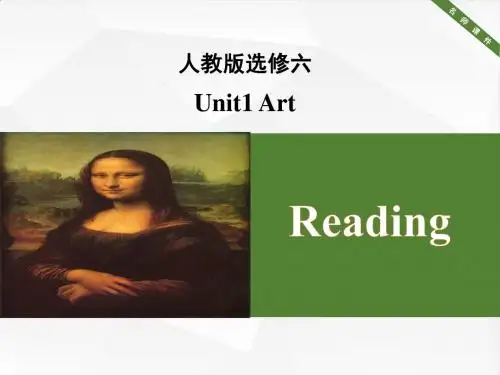
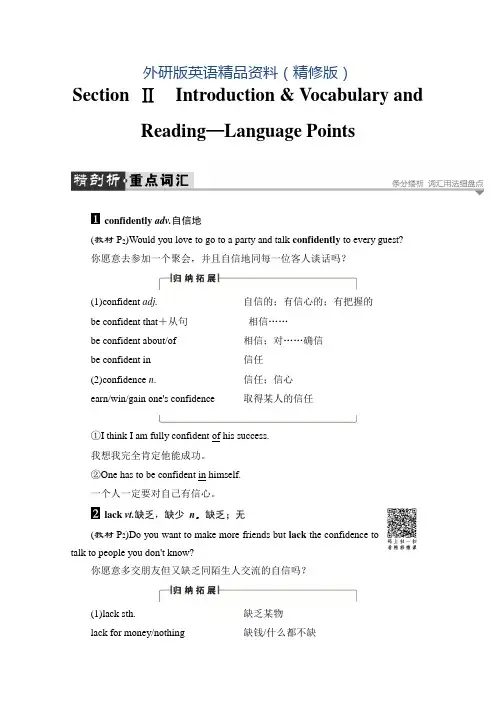
外研版英语精品资料(精修版)Section ⅡIntroduction & Vocabulary and Reading—Language Pointsconfidently adv.自信地(教材P2)Would you love to go to a party and talk confidently to every guest?你愿意去参加一个聚会,并且自信地同每一位客人谈话吗?(1)confident adj.自信的;有信心的;有把握的be confident that+从句相信……be confident about/of 相信;对……确信be confident in 信任(2)confidence n. 信任;信心earn/win/gain one's confidence 取得某人的信任①I think I am fully confident of his success.我想我完全肯定他能成功。
②One has to be confident in himself.一个人一定要对自己有信心。
lack vt.缺乏,缺少n.缺乏;无(教材P2)Do you want to make more friends but lack the confidence totalk to people you don't know?你愿意多交朋友但又缺乏同陌生人交流的自信吗?(1)lack sth. 缺乏某物lack for money/nothing 缺钱/什么都不缺(2)lack n. 缺少,缺乏the/a lack of... ……不足for lack of 因缺乏……(3)lacking adj.缺少的,缺乏的be lacking in 缺乏;没有①Lack of money is the root of all evil.缺乏金钱是万恶之源。
②He is lacking in responsibility.他缺乏责任心。

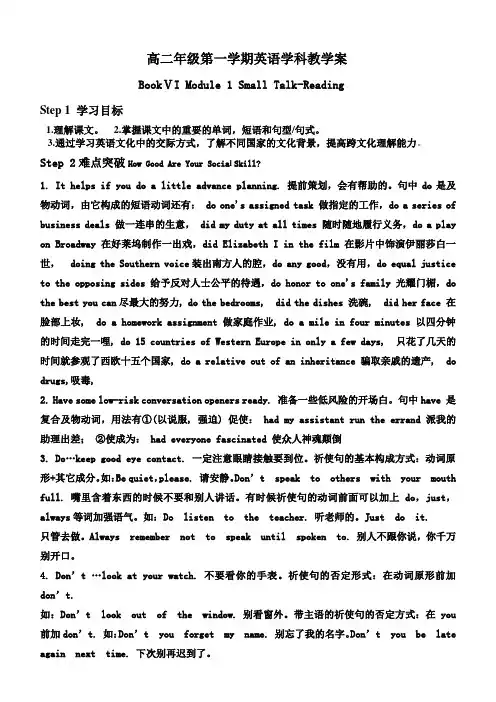
高二年级第一学期英语学科教学案BookⅤI Module 1 Small Talk-ReadingStep 1 学习目标1.理解课文。
2.掌握课文中的重要的单词,短语和句型/句式。
3.通过学习英语文化中的交际方式,了解不同国家的文化背景,提高跨文化理解能力。
Step 2难点突破How Good Are Your Socia l Skill?1. It helps if you do a little advance planning. 提前策划,会有帮助的。
句中do是及物动词,由它构成的短语动词还有: do one's assigned task 做指定的工作,do a series of business deals 做一连串的生意, did my duty at all times 随时随地履行义务,do a play on Broadway 在好莱坞制作一出戏,did Elizabeth I in the film 在影片中饰演伊丽莎白一世, doing the Southern voice装出南方人的腔,do any good,没有用,do equal justice to the opposing sides 给予反对人士公平的待遇,do honor to one's family 光耀门楣,do the best you can尽最大的努力, do the bedrooms, did the dishes 洗碗, did her face 在脸部上妆, do a homework assignment 做家庭作业, do a mile in four minutes 以四分钟的时间走完一哩, do 15 countries of Western Europe in only a few days, 只花了几天的时间就参观了西欧十五个国家, do a relative out of an inheritance 骗取亲戚的遗产, do drugs,吸毒,2. Have some low-risk conversation openers ready. 准备一些低风险的开场白。
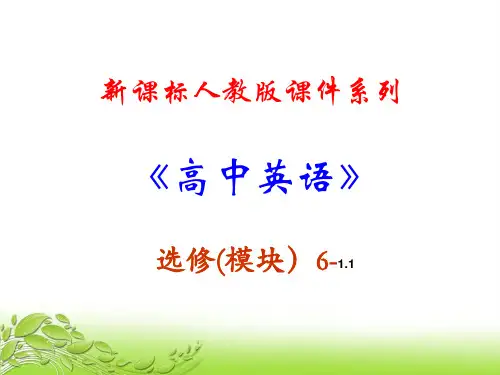
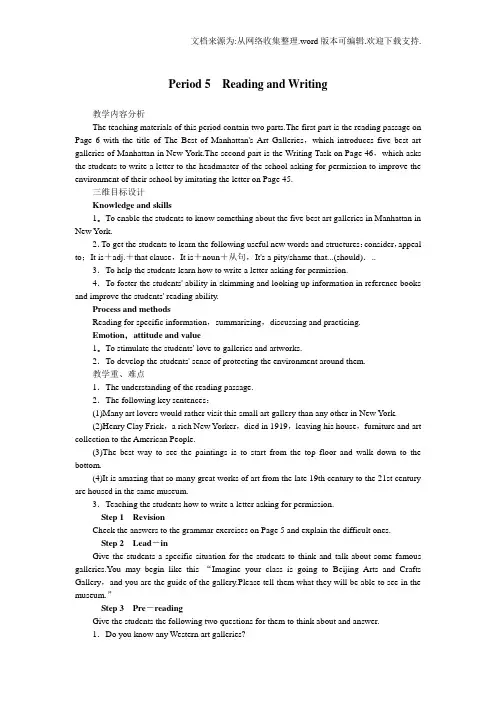
Period 5Reading and Writing教学内容分析The teaching materials of this period contain two parts.The first part is the reading passage on Page 6 with the title of The Best of Manhattan's Art Galleries,which introduces five best art galleries of Manhattan in New York.The second part is the Writing Task on Page 46,which asks the students to write a letter to the headmaster of the school asking for permission to improve the environment of their school by imitating the letter on Page 45.三维目标设计Knowledge and skills1.To enable the students to know something about the five best art galleries in Manhattan in New York.2.To get the students to learn the following useful new words and structures:consider,appeal to;It is+adj.+that clause,It is+noun+从句,It's a pity/shame that...(should)...3.To help the students learn how to write a letter asking for permission.4.To foster the students' ability in skimming and looking up information in reference books and improve the students' reading ability.Process and methodsReading for specific information,summarizing,discussing and practicing.Emotion,attitude and value1.To stimulate the students' love to galleries and artworks.2.To develop the students' sense of protecting the environment around them.教学重、难点1.The understanding of the reading passage.2.The following key sentences:(1)Many art lovers would rather visit this small art gallery than any other in New York.(2)Henry Clay Frick,a rich New Yorker,died in 1919,leaving his house,furniture and art collection to the American People.(3)The best way to see the paintings is to start from the top floor and walk down to the bottom.(4)It is amazing that so many great works of art from the late 19th century to the 21st century are housed in the same museum.3.Teaching the students how to write a letter asking for permission.Step 1RevisionCheck the answers to the grammar exercises on Page 5 and explain the difficult ones.Step 2Lead-inGive the students a specific situation for the students to think and talk about some famous galleries.You may begin like this “Imagine your class is going to Beijing Arts and Crafts Gallery,and you are the guide of the gallery.Please tell them what they will be able to see in the museum.”Step 3Pre-readingGive the students the following two questions for them to think about and answer.1.Do you know any Western art galleries?2.Have you ever been to any Western galleries before? If so,describe your visit. Step 4Fast reading1.Numbers on the map MuseumsThe Frick CollectionGuggenheim MuseumMetropolitan Museum of ArtMuseum of Modern ArtWhitney Museum of American ArtNumbers on the map Museums4 The Frick Collection1 Guggenheim Museum2 Metropolitan Museum of Art5 Museum of Modern Art3 Whitney Museum of American Art2.Skim the text,and answer the following questions.(Slide show)Suggested answers:(1)The passage introduces some best art galleries of Manhattan.(2)Possibly in a guide book.(3)Tourists and art gallery visitors.Step 5Detailed readingName Address Which centuries?What countries?America Museum of Modern ArtFrom ancient to modern timesGuggenheim Museum Western countries The Frick Collection Western countriesName Address Which centuries?What countries?Whitney Museum of American Art 945 Madison Avenue,near 75th StreetContemporary(mainlyart by living artists)AmericaMuseum of Modern Art 53rd Street,between5th and 6th AvenuesFrom the late 19thcentury to the 21stcenturyWestern countriesMetropolitan Museum of Art 5th Avenue & 82ndStreetFrom ancient tomodern timesAll over the worldGuggenheim Museum 5th Avenue & 88thStreet[来源:]Modern(from the late19th century onwards)Western countriesThe Frick Collection 5th Avenue and E.70thStreetPre-twentieth century Western countriesEnjoy the following pictures and discuss the following questions.Which of the five galleries would you like to visit?Why?Guggenheim MuseumMetropolitan Museum of Art Whitney Museum of American ArtThe Frick Collection Museum of Modern ArtStep 7Language studyShow the students the following language points in the passage in a slide show. 1.appeal to(P6)【原句再现】It will appeal_to those who love Impressionist and Post-Impressionist paintings. 展览将吸引印象派和后印象派作品的爱好者。
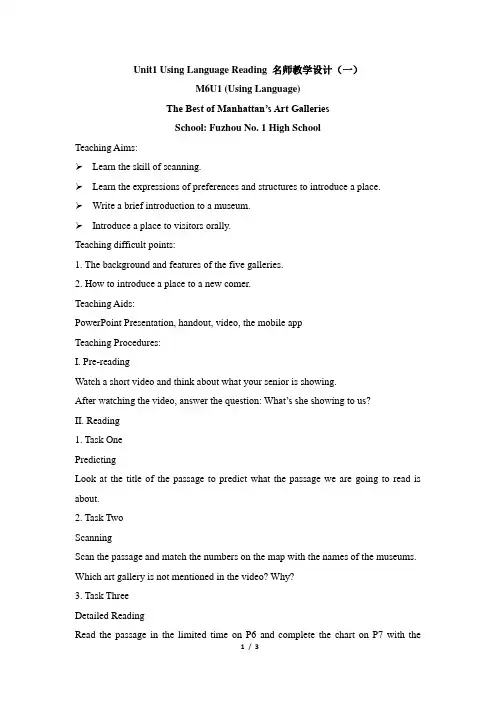
Unit1 Using Language Reading 名师教学设计(一)M6U1 (Using Language)The Best of Manhattan’s Art GalleriesSchool: Fuzhou No. 1 High SchoolTeaching Aims:➢Learn the skill of scanning.➢Learn the expressions of preferences and structures to introduce a place.➢Write a brief introduction to a museum.➢Introduce a place to visitors orally.Teaching difficult points:1. The background and features of the five galleries.2. How to introduce a place to a new comer.Teaching Aids:PowerPoint Presentation, handout, video, the mobile appTeaching Procedures:I. Pre-readingWatch a short video and think about what your senior is showing.After watching the video, answer the question: What’s she showing to us?II. Reading1. Task OnePredictingLook at the title of the passage to predict what the passage we are going to read is about.2. Task TwoScanningScan the passage and match the numbers on the map with the names of the museums. Which art gallery is not mentioned in the video? Why?3. Task ThreeDetailed ReadingRead the passage in the limited time on P6 and complete the chart on P7 with theinformation from the reading passage.Figure out the features of four art galleries.4. Task FourRead for writingScan the passage and circle all the expressions of preferences mentioned in it, including those expressions you like. Figure out the meanings of these expressions. III. Post reading1. Task OneListen for writingWatch a short video of Whitney Museum of American Art and introduce the last art gallery that Shu Lin has missed, using those expressions we have learned today. Founder: Gertrude Vanderbilt Whitney格特鲁德范德比尔特惠特尼(Lady Whitney)[ˈɡə:tru:d][ˈvændəbilt]Founding time: 1931It was the first museum to focus exclusively on art and artists of the United States.It moved to the border of the Hudson River in 2015. It has been moved three times. 2. SpeakingNext year comes the two hundredth anniversary of our school. Shu Lin is going to bring some foreign friends to our school.Ask the students to choose one place to introduce from the followings according to their preference. Some information given to the students:Library: Tongruo English Library (more than 14,000 original English books),the Third Library Observatory(天文台): A telescope and other equipment (one million yuan in total)Gymnasium: a newly-built fitness centerDear friends,Welcome to Fuzhou No. 1 High School. 2017 is the two hundredth anniversary of our school. I’m glad to show you around our beautiful c ampus. _____________________Homework:1. Review the expressions of preferences and structures to introduce a place.2. Do the listening exercises on P7.3. Choose from the supplemental materials offered to you and know more about art galleries.4. Enjoy the video, Art City, New York in your spare time.。
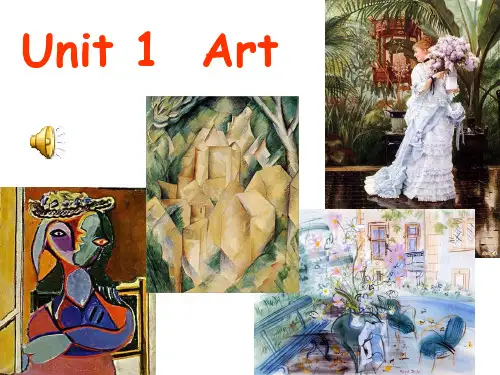
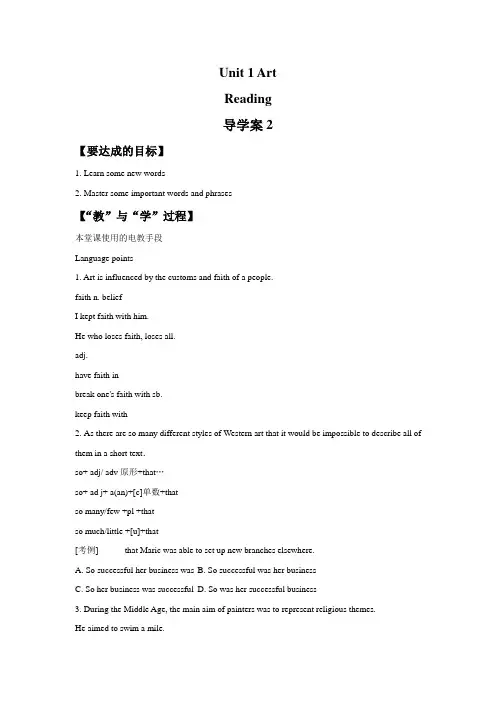
Unit 1 ArtReading导学案2【要达成的目标】1. Learn some new words2. Master some important words and phrases【“教”与“学”过程】本堂课使用的电教手段Language points1. Art is influenced by the customs and faith of a people.faith n. beliefI kept faith with him.He who loses faith, loses all.adj. __________have faith in _______________break one's faith with sb. _______________________keep faith with ____________________________2. As there are so many different styles of Western art that it would be impossible to describe all of them in a short text.so+ adj/ adv原形+that…so+ ad j+ a(an)+[c]单数+thatso many/few +pl +thatso much/little +[u]+that[考例] _____ that Maric was able to set up new branches elsewhere.A. So successful her business wasB. So successful was her businessC. So her business was successfulD. So was her successful business3. During the Middle Age, the main aim of painters was to represent religious themes.He aimed to swim a mile.What is your aim in life?adj. _____________ 无目的, 无目标的These measures ______ reducing government expenditure.(这些措施旨在削减政府的开支。
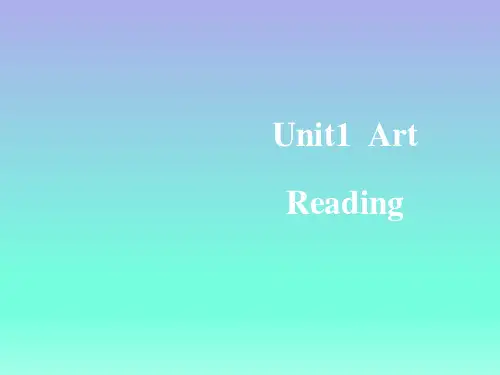
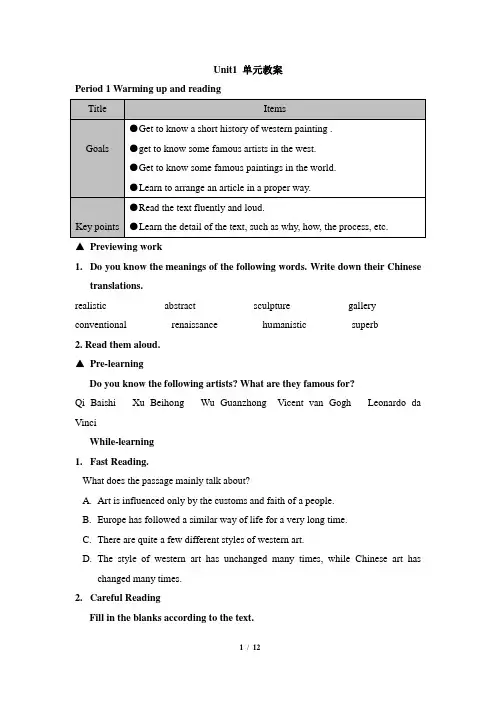
Unit1 单元教案Period 1 Warming up and reading▲Previewing work1.Do you know the meanings of the following words. Write down their Chinesetranslations.realistic_________ abstract_________ sculpture_________ gallery_________ conventional_________renaissance_________humanistic_________superb________ 2. Read them aloud.▲Pre-learningDo you know the following artists? What are they famous for?Qi Baishi Xu Beihong Wu Guanzhong Vicent van Gogh Leonardo da VinciWhile-learning1.Fast Reading.What does the passage mainly talk about?A.Art is influenced only by the customs and faith of a people.B.Europe has followed a similar way of life for a very long time.C.There are quite a few different styles of western art.D.The style of western art has unchanged many times, while Chinese art haschanged many times.2.Careful ReadingFill in the blanks according to the text.period time theme Related informationThe middle ages 5th-15th centuryAD 1.________________Style: to paint ina(n)2._________wayThe renaissance 15th-16th century People and3.____________ New techniques:4.___________ was first used and5.__________ paints were also developed.6.________ Late 19th–early20th century To show how7.________ andshadow fell onobjects at differenttimes of day.Characteristics:painters worked8._________ andpainted quickly.Modern art 20th century-today To look at their9._______ in newways.Styles: to paint ina(an) 10._______ orrealistic way.▲Post-learning.1. What art style do you like best? Discuss with your partners, and show your suggestions.2. Read the passage again and again till you can read it fluently.▲Work after classFinish Ex.1 , P42【用法理解】1)[u] faith in sb/sth 信任;相信;信心He has gr eat talent, but he has lost his faith.I haven’t much faith in this medicine.2) [u] 信仰【归纳拓展】1)have faith in _________2)break / keep faith with sb 对某人(不)守信用;(不)忠诚于某人3)lose faith in _________辨析:faith, belief, confidence, trust这些名词都有“相信,信任”的意思1)faith语气较强,指“认为有确凿的证据或道理而完全相信”。
Unit 1 ArtPeriod1 Vocabulary and Useful ExpressionsTeaching Goals:1.To enable Ss to master some new words and expressions2.To get Ss to have knowledge of this grammar point: the subjective moodTeaching Procedures:Step 1. Free talkIf you have a special chance to become a poet, what kind of poems will you write to people?And why?Step 2. Word studyPurpose: To consolidate the words and phrases in the text.1.Find a word in the poems that rhymes with each of the words below. Then add other words that rhyme. The first one has been done for you.(1)dead lead red thread fed said bed(2)high(3)sing(4)today(5)lace(6)trueSuggested Answers:(2)high sky pie my fly shy lie(3)sing ring wing thing king fling string(4)today away say play lay tray may(5)lace race face case chase place space(6)true too new flew few shoe canoeplete the passage using the words below in the correct form.c o t t a g e r u n o u t o f n u r s e r y r h y t h m r e c i t e r h y m eWhen I was a baby, my mother used to read me rhymes, I loved their and the way the words at the end of the lines. By the time I was two years old, I could at least ten of them. When we new nursery rhymes, my mother would go to the store to buy another nursery rhyme book. In fact, my family loved reading so much that the living room in our was full of books.Suggested Answers:nursery; rhythm; rhyme; recite; run out of; cottage.3.In English we sometimes add –ful to a noun to make an adjective. For example, wonder becomes wonderful. This means full of wonder. Now make adjectives form these nouns. Then add four other pairs you know.(1)beauty (5) dread (9)(2)joy (6) hope (10)(3)sorrow (7) peace (11)(4)delight (8) power (12).Suggested Answers:(1) beautiful (2) joyful (3) sorrowful (4) delightful (5) dreadful(6) hopeful (7) peaceful (8) powerful (9) thankful (10) successful (11) painful (12) usefulplete the table with the correct nouns, verbs, adjectives or adverbs.Verb AdverbNoun AdjectiveangrydarkenimpressiverepetitivetransformationaltranslationwarmenjoyexpressivelyinspireSuggested Answers:Verb AdverbNoun Adjectiveanger anger angry Angrilydark darken dark darklyimpression impress impressive impressively repetition repeat repetitive repetitively transformation transform transformational \translation translate translated \warmth warm warm wrmlyenjoyment enjoy enjoyable enjoyably expression express expressive expressively inspiration inspire inspirational inspirationallyplete each sentence using the correct word from the table you have just completed. (1)While you were reciting the poem, I think you moved your body very . It made the performance much more interesting.(2)Ad I lay in the , the words of a new poem came into my head.(3)The teacher doesn’t think that the of the Tang poem is very good.(4)Songs are often easy to remember because they a lot of poetry.(5)Your talk was so that I want to go and write lots of poetry.(6)I loved the strong images you used in your poem to convey feelings of .(7)We were very by the students’ performance of their poetry.(8)We passed the afternoon very reading poetry together under the trees.(9)Mr. Tanne r’s love of poetry has the students’ feelings towards the subject.(10)Even though it is cold, your poem about summer has made me feel really . Answers:(1) expressively (2) darkness (3) translation (4) repeat (5) inspirational (6) anger (7) impressed (8) enjoyably (9) transformed (10) warm Step 3. Grammar1.PresentationPurpose: To revise the usage of the subjunctive mood with Ss.所述情况从句主句与现在事实相反If+主语+动词过去式主语+ would/could/might/should+ (be 动词用were)动词原形与过去事实相反If+主语+动词过去完成式主语+ would/could/might/should+have + 过去分词与将来事实相反①if+主语+动词过去式主语+ would/could/might/should+②if+主语+were to + 动词原形动词原形③if+主语+should+动词原形此表中需要注意几点:(1) be 动词在表示与现在事实相反的从句中一般用were.在非正式情况先,第一、第三人称后偶尔也用was. 如:If he were you, he would go at once.(2) 主句中的should 通常用于第一人称,would,could 以及might 可以用于各种人称。
高二 Unit 1 artproject ArtPeriod OneAims and demands 1. Enable the Ss know sth about the style of the western art and some fam ous artists .2. Learn some new words and expressions.3. Comprehend the reading passage.Main points Warming up and Reading comprehedingDifficult points Comprehend the reading pass ageTeaching procedures Step One warming up1.?Show the Ss some works of some famous artists;ask them to say something they know about the pictures.2.?The Ss discuss the questions in warming up in groups and walk along to listen and offer th em help if needed.3.?Ask some students to answer the following questions:1. What do we call these things like sculptures and paintings which can make our school more beautiful?2. If you could have three of these paintings on the walls of your classroom or your home, whi ch would you choose? Give the reasons.3. Would you rather have Chinese or Western-style paintings in your home?Give your reasons .4. Have you ever wished you would paint as well as a professional artist? If you were an artist , what kind pictures would you paint?5. What would you rather do--- paint pictures, make sculptures, or design buildings? Why?4.燬ay anything they like about the artists and the works.5.Ask some more stude nts to say more about the pictures and the choices .Step Two pre-reading1.?The Ss discuss the questions in pre-reading.1.Do you ever visit art galleries?2.What kind of paintings have you seen in galleries or in books?3.What are the names of some famous Western artists?Do you know in which century they liv ed ?2.Show the students some pictures of some famous gallerirs in the world and say sth.about the m.Step Three Reading passage1.?Fast reading. Let the Ss go over passage as fast as possible and try to find the hard words, e xpressions and sentences they have and try to decide which statement is true or false.2.燙hoose some Ss to read the sentences and tell others about their answers.3. Listen to the tape of the text and fill in the chart.Name of Ages Time Artist FeatureThe middle AgesThe RenaissanceImpressionismModern Art4. Extensive reading. Ask the Ss to read the passage more carefully and then try to get the mai n idea of each paragraph5.?Ask the Ss to report their idea, choose the best one.Notes:focus on,a great deal,scores of,attempt to .Step Four homeworkRead the passage again and finish the first Ex1 by wrting down their opinion.Go over Learning about language and finish the exercises by themselves first.Teaching plan for Unit One ArtClassDateproject ArtPeriod Two learning about languageAims and demands 1. Discover the useful words and expressions.2. Learn and improve the use of useful words and expressions.Main points Learn to use the words and expressions that the Ss discover.Difficult points Improve the use of the words and expressions.Teaching procedures Step One Learning about language1.?Discover the useful words and expressions in this unit in groups of four.2.?Ask the Ss to show their results to the class.3.?Ask them to find out some of the time expressions and underline all those time expressions in the reading passage.4.?Ss have a discussion and do the exercise2.5.?Check their answers.6.?Say sth. about the word-formation and try to find out the root of the words below.plete the sentences with the words in the passages.Step two Using words and expressions1. Review the rules of changing the forms of the words:verb-noun-adjective .2.?Let the Ss discuss the questions below:1. What part of speech are the words ending in-ion?Are there any exceptions to this?2.For most words,is the verb,noun or adjective the shortest word?3.What endings do the adjectives have?Can you think of other common endings for adjectives ?plete the sentences with the words above.5.?Do the translations. Ss discuss the sentences and the translate them into English, using the words and phrases in brackets.Step three words learning1. Ask the Ss to talk about the word-formation.2.?Ask them to work in groups to find some words with the prefixes and suffixes and study th eir meanings.3.?Ask them to show their results to the class.4.?Walk around the class to give them help if needed.Step four Talking.1.?Ask the Ss to discuss the questions:1.Who are your favourite artists,both from China and from other countries?2.燱hat kind of art do you prefer:traditional or modern,abstract or figurative,painting or photograp hy,two-dimensiional orthree-dimensional?Step five HomeworkWrite down the translati on in the exercice book.Teaching plan for Unit One ArtClassDateproject ArtPeriod Three learning about languageAims and demands 1. Discover the useful structure.2. Learn the grammar of subjunctive mood.3. Enable the Ss to use the subjunctive mood.Main points Subjunctive moodDifficult points Subjunctive moodTeaching procedures Step One revisionReview the ellipsis and inversion together first .Step Two learning the useful structureAsk the Ss to find out more sentences in the passage with the same structure of the following sentence:If you were an artist,what kind of pictures would you paint?Ask some Ss to write down what they found on the blackboard.Check together.Ask the Ss to complete the sentences by discussion.David isn抰 thirsty.If he___(be),he _____(drink) the lemonade they offered.Sally is not an aggressive person.If she ___(be),she____(be)a more successful business wome n.卐tc.Step Three WorkbookFill in the chart using the subjunctive mood to present the wishes of the people.Real:I am not beautiful.Wish:I wish I were beautiful.Check their answers.Ask the Ss to think of other wishes that can抰 be realized so easily.plete the sentences using the subjunctive mood.Step four HomeworkWrite down Ex.3 in the workbook in the exercise book.Teaching plan for Unit One ArtClassDateproject ArtPeriod Four using language ListeningAims and demands 1.牋?Improve the Ss?listening skills.2.牋?Know more about the art.Main points Listening and speakingDifficult points Get to know the information of listening materials.Teaching procedures Step One Listening and speaking1.牋?Listen to the tape and answer the questions.1.Who first suggested they visit art galleries?2.Who is the least interested in visiting art galleries?3.Why is GaoYan interested in visiting the Metropolitan Museum?4.Does Susan prefer large or small galleries?5.Why doesn抰 Susan want to go to the Museum of Modern Art?6.What kind of art does Susan dislike?7.Which two galleries do they decide to vistit on Friday and which two galleries on Saturday? Step Two speaking1.Think about your own school environment.Step Three Listening and talking1.牋 Play the tape for the Ss to listen and finish the exercises in the workbook , pause from time to time if needed.2.牋 After listening,ask the Ss to decide which centuries the works belonged to.3. Before they listen to the tape again,discuss these questions with a partner and then listen and check.Step Four listening task1.牋?Play the tape for the Ss to get the information of the listening task.2.牋?Check their answers.Step Five HomeworkPrepare the reading task.Teaching plan for Unit One ArtClassDateproject ArtPeriod Five Reading and reading taskAims and demands Improve the Ss reading skills and their talent in getting the information. Main points Reading and reading taskDifficult points Finding more information about the artTeaching procedures Step one RevisionRevise the subjunctive mood :If I ran into a dinosaur in the forest,I would __________________.If I met Pavarotti in the flesh,Iwould_______________.Step two Reading tasking1.?Ss read the passage as fast as they can and then fill in the chart by themselves Letter from ___________Asking for __________and _______________Reason __________________________Their plan:1._________________2._________________3._________________Work will be done by:___________________2.?Ask the Ss to report their answers to the class.3.?Ss read the passage again and find more information as they can.4.?Choose some Ss to share their ideas to the class.Step three Readingplete the chart after reading passage2.燫ead the passage again and match the names to the museum.3.?Ss work in groups.Step four HomeworkWrite a short passage about your favourite artists.Teaching plan for Unit One ArtClassDateproject ArtPeriod SixAims and demands 1. Try to write a letter .Main points Write a letter to the headmaster of the school asking for permission.Difficult points Write the letter.Teaching procedures Step one Writing1.Ask the Ss to read the letter on page 45 again and:1.find out the problem.2.how to solve it.3.begin to write.2. Plan to write the letter .1.Ss work in groups to make up a plan of writing. They can follow the example in the book on P45.2.Ask the Ss to read their plans.3.Write their passages in groups, when finished,ask the Ss to read in class.Step two WritingWrite a letter to the art gallery committee,giving your suggestions and reasons for starting this new art gallery.1. Ask the Ss to discuss first to find out more problems and the choose the one that they think is the most serious and the most important.2. Make a plan ,try to solve it peacefully.List all the ways.3. Ask them to write down the letter and ask them to pay more attention to finish the letter pol itely.4. Read their letters.Step three Summing upAsk the Ss to sum up all the new words and expressions that have learned in this unit.The grammmer.Sth about the art.Step four HomeworkComplete the letter and write down on the exercise book.。
Unit 1 ArtWarming up, Reading & Comprehending编号:032 编写者:焦丽勇审核者:焦丽勇学习目标:1、了解西方油画艺术的历史及不同的艺术风格,著名艺术家。
2、学会分析课文中的长难句,概括文章的主旨大意,并理解语篇中的重要细节。
3. 培养对艺术的热爱,学会欣赏艺术,建立正确的艺术审美观。
创设学习情境:1.New words_____________ adj. 抽象的,深奥的n. 摘要反义词:concrete ________ n.____ _____________ n. 信任,信心,信念___________adj. _______________adv.consequently adv. ____________ ; _________ adj. 作为结果的____________ n. 结果_____________ adj..明显的,明白的近义词:_________________________ vt. 采用,采纳,收养拼写相近的词:adapt __________________________ vt. 拥有,具有,支配____________________ n. 所有,财产_____________ adj. 卓越的,杰出的,极好的近义词________,_________________________ vt. 预言,预告,预测____________ n. 预言,预报2.What does art include?___________________________________________________________________3.Can you name some famous painting and painters?_________________________________________________________________________ _________________________________________________________________________ _________________________________________________________________________ 学习任务:I 语篇理解1. What’s the main idea?_________________________________________________________________________ 2. How many styles of Western painting are mentioned in the text? What are they?_________________________________________________________________________ _________________________________________________________________________ 3. 完成《一线精练》P1课时练习1 I题、II 题II. Detailed reading1. 找出文中重要短语:_______________ 如实地__________________ 以更加现实的方式________________ 新的思想和价值观_________________ 集中________________ 对……的态度__________________ 用透视法________________ 相信,以为__________________ 透过墙上的洞________________ 巧合地__________________ 大量,许多________________ 挣脱,摆脱,背离__________________ 热切地做某事_________________ 被接受为__________________ 我们所称的现代艺术_________________ 鼓励某人做某事_________________ 企图试图做某事__________________ 用眼睛看_________________ 物体的特性__________________ 另一方面__________________ 在将来V 难句攻关1. (Line 2-4)As there are so many different styles of Western art, it would be impossible to describe all of them in such a short text. Consequently, this text will describe only the most important ones, starting from the sixth century AD.结构分析:① As 在本句中引导的为______状语从句,意为”______”。
②it 为形式主语,其真正主语为_____________________________。
③ones在此为替代词,指_________。
④starting from …为现在分词作__________,相当于_____________________________。
译文:______________________________________________________________________ ____________________________________________________________________________ 2. (Line 36-38)Among the painters who broke away from the traditional style of painting were the Impressionists, who lived and worked in Paris.结构分析:①本句的主干为_________________________________,此句为______语序, 正常语序为__________________,who lived and worked in Paris,___________________ who broke away from the traditional style of painting.译文:_______________________________________________________________________ 3. (Line 52-55) On the one hand, some modern art is abstract; that is, the painter does not attempt to paint objects as we see them with our eyes, but instead concentrates on certain qualities of the object, using colour, line and shape to represent them.结构分析:①该句中as引导的为_________状语从句,意为“______”;②not … ,but …连接两个_______ 句;③using colour, line and shape to represent them.为现在分词作________状语。
译文:_______________________________________________________________________ ____________________________________________________________________________Unit 1 Artlanguage points (I)编号:033 编写者:王淑丽焦盛楠审核者:焦丽勇学习目标:1、理解并运用重要语言点,如would rather, faith, consequence, aim, typical, adopt的用法。
2、掌握词汇在具体语境中的含义、词性和用法。
.学习任务:语言知识探究1.abstract(教材P1) adj.抽象的;深奥的______________ 抽象艺术_____________ 抽象思维2.Would you rather have Chinese or Western-style paintings in your home?(教材P1)在你的家里,你愿意悬挂中国画还是西洋画?He doesn't want to learn—he would rather __________________ video games.他不想学习——他宁愿待在家里玩电子游戏。
[归纳拓展]_____________________ 宁愿做某事would rather not do sth.宁愿不做某事would rather__________________ 宁愿做……而不做……= would do…_______________ would rather _____________ .宁愿某人做……[语境助记]I'd rather ____________ at the airport tomorrow. 我宁愿你明天在机场见到他。
I would walk there rather than take a bus. 我宁愿步行去那里也不愿乘公共汽车。
= ____________________________________________.3. As there are so many different styles of Western art,it would be impossible to decribe all of them in such a short text.(教材P1)由于西方的艺术风格多种多样,在短短的一篇课文里不可能进行全面的描述。
________________________________ 做……是不可能的。
[语境助记]______________________________ the future accurately. 精确预测未来是不可能的。